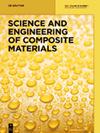低速碰撞下摩擦系数和角度对眩光失效行为影响的仿真研究
IF 1.6
4区 材料科学
Q3 Materials Science
引用次数: 0
摘要
摘要本文旨在研究摩擦系数和冲击角对玻璃纤维增强铝层压板(GLARE)在低速冲击(LVI)载荷下破坏行为的影响。在商业软件ABAQUS/Explicit中开发了一种方法,并通过仿真与实验对比验证了该方法的准确性。在模拟中,采用Johnson-Cook流动应力模型和基于表面的内聚行为来模拟铝合金层的损伤演化和界面处的分层。此外,对混合层合板的动态响应历史和损伤机理特征进行了详细的比较。此外,由于仿真的优势,可以准确、方便地讨论由复合材料层与金属层的损伤程度及其界面组成的损伤轮廓的演变过程。最后,明确了LVI下摩擦系数和角度对眩光失效行为的影响规律。本文章由计算机程序翻译,如有差异,请以英文原文为准。
A simulative study on the effect of friction coefficient and angle on failure behaviors of GLARE subjected to low-velocity impact
Abstract The aim of this paper is to study the effect of friction coefficient and impact angle on the failure behaviors of glass fiber reinforced aluminum laminates (GLARE) under the low-velocity impact (LVI) loading. A methodology is developed in commercial software ABAQUS/Explicit, and its accuracy is verified based on the results of comparison between simulation and experiment. In the simulation, Johnson–Cook flow stress model and surface-based cohesive behavior are carried out to simulate the damage evolution of aluminum alloy layers and delamination at the interface. Further, both the dynamic response history and damage mechanism characterization of these hybrid laminates are presented and compared carefully. Additionally, due to the advantage of simulation, it is accurate and easy to discuss on the evolution of the damage contour consisting of the damage degree of composite and metal layers as well as the interface between them. Finally, the influence rules of friction coefficient and angle on the failure behaviors of GLARE under LVI are drawn clearly.
求助全文
通过发布文献求助,成功后即可免费获取论文全文。
去求助
来源期刊

Science and Engineering of Composite Materials
工程技术-材料科学:复合
CiteScore
3.10
自引率
5.30%
发文量
0
审稿时长
4 months
期刊介绍:
Science and Engineering of Composite Materials is a quarterly publication which provides a forum for discussion of all aspects related to the structure and performance under simulated and actual service conditions of composites. The publication covers a variety of subjects, such as macro and micro and nano structure of materials, their mechanics and nanomechanics, the interphase, physical and chemical aging, fatigue, environmental interactions, and process modeling. The interdisciplinary character of the subject as well as the possible development and use of composites for novel and specific applications receives special attention.
 求助内容:
求助内容: 应助结果提醒方式:
应助结果提醒方式:


